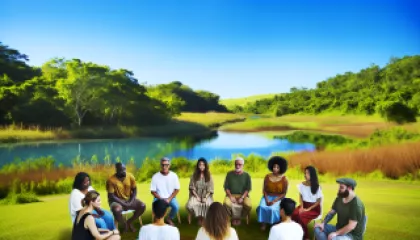Top 10 Technieken om Je Intuïtie te Scherpen
Intuïtie, vaak aangeduid als het zesde zintuig of onderbuikgevoel, is een krachtig mentaal gereedschap dat ons kan leiden door de complexiteit van het leven. Het is een instinctief bewustzijn dat inzichten biedt die verder reiken dan ons bewuste begrip. Het verfijnen van deze vaardigheid stelt ons in staat om betere beslissingen te nemen, creatiever te worden en een vervullender leven te leiden.
Hier zijn tien effectieve technieken die je kunnen helpen je intuïtie te scherpen. Elke methode is bewezen en betrouwbaar, en door ze in je dagelijks leven op te nemen, zul je waarschijnlijk significante verbeteringen in je intuïtieve vermogens opmerken.
1. Mindfulness Meditatie
Meditatie is een wetenschappelijk bewezen techniek om verschillende cognitieve vermogens te verbeteren, waaronder intuïtie. Het helpt ons onze geest vrij te maken van ruis, waardoor we beter naar onze innerlijke stem kunnen luisteren.
Oefen regelmatig mindfulness meditatie om in contact te komen met je innerlijke zelf. Dit houdt in dat je je aandacht richt op je ademhaling en de gedachten en sensaties die opkomen erkent, zonder oordeel.
Na verloop van tijd zul je merken dat je intuïtie scherper en verfijnder wordt.
2. Regelmatig Schrijven in een Dagboek
Het bijhouden van een dagboek kan een effectieve manier zijn om contact te maken met je intuïtie. Door je gedachten en gevoelens op te schrijven, creëer je ruimte om patronen te verkennen en te identificeren die anders misschien onopgemerkt zouden blijven.
Probeer een regelmatige gewoonte van dagboekschrijven aan te houden. Je zult misschien steeds terugkerende thema's of inzichten opmerken, die je intuïtie kunnen zijn die met je communiceert.
3. Tijd Doorbrengen in de Natuur
De natuur heeft een manier om onze geest tot rust te brengen en ons open te stellen voor diepere niveaus van denken. Tijd doorbrengen in de buitenlucht kan ons helpen weer in contact te komen met ons innerlijke zelf en onze intuïtieve vermogens te verbeteren.
Maak er een punt van om elke week wat tijd in de natuur door te brengen. Of het nu een wandeling in het park is, een wandeling in de bergen of gewoon aan een meer zitten, deze ervaringen kunnen je helpen af te stemmen op je intuïtie.
4. Vertrouw op je Intuïtie
Je onderbuikgevoelens zijn vaak je intuïtie die tegen je spreekt. Als iets niet goed voelt, is dat waarschijnlijk ook zo. Begin deze onderbuikgevoelens te vertrouwen en er vaker naar te handelen.
Dit betekent niet dat je impulsieve beslissingen moet nemen, maar eerder dat je je onderbuikgevoelens als waardevolle informatie moet beschouwen die je besluitvormingsproces kan sturen.
5. Luister naar je Dromen
Dromen kunnen vaak inzichten bieden die je bewuste geest over het hoofd zou kunnen zien. Ze kunnen een rijke bron van intuïtieve wijsheid zijn.
Probeer een droomdagboek bij te houden en noteer alles wat je je herinnert bij het ontwaken. Na verloop van tijd zul je misschien patronen of berichten opmerken die belangrijk kunnen zijn.
6. Cultiveer Stilte
In onze lawaaierige, snelle wereld is stilte een zeldzaam goed geworden. Toch kan tijd doorbrengen in stilte een uitstekende manier zijn om af te stemmen op je intuïtie.
Probeer dagelijks een paar minuten in stilte te zitten. Deze oefening kan je helpen meer bewust te worden van je innerlijke stem en intuïtieve aansporingen.
7. Beoefen Mind-Body Technieken
Mind-body technieken zoals yoga en tai chi zijn ontworpen om een diepe verbinding tussen het fysieke lichaam en de geest te bevorderen. Deze verbinding kan je intuïtieve vermogens vergroten.
Kies een mind-body praktijk die bij je past en neem het op in je wekelijkse routine. Naarmate je meer in contact komt met je lichaam, zul je waarschijnlijk merken dat je intuïtie ook scherper wordt.
8. Gebruik Intuïtie-versterkende Hulpmiddelen
Er zijn verschillende hulpmiddelen beschikbaar die je intuïtieve vermogens kunnen versterken. Dit omvat tarotkaarten, runen en pendels.
Hoewel deze hulpmiddelen niet noodzakelijk zijn voor het ontwikkelen van intuïtie, kunnen ze dienen als nuttige hulpmiddelen om je geest te focussen en intuïtieve inzichten te interpreteren.
9. Let op je Lichamelijke Reacties
Ons lichaam reageert vaak instinctief op situaties voordat onze bewuste geest de informatie volledig heeft verwerkt. Door aandacht te besteden aan deze lichamelijke reacties kunnen we putten uit onze intuïtieve kennis.
Neem de volgende keer dat je voor een beslissing staat even de tijd om je lichaam te observeren. Voel je je gespannen of ontspannen? Heb je last van je maag of voel je een gevoel van rust? Deze lichamelijke reacties kunnen waardevolle intuïtieve inzichten bieden.
10. Voed je Geest
Een gezonde geest heeft meer kans op een sterke intuïtie. Dit omvat het handhaven van een uitgebalanceerd dieet, voldoende slaap, regelmatige lichaamsbeweging en mentaal gestimuleerd blijven.
Zorg goed voor je geestelijke gezondheid en welzijn, en je zult merken dat je intuïtie van nature verbetert.
Tot slot is intuïtie een krachtig gereedschap en met oefening en geduld kan iedereen leren het effectief te benutten. De bovengenoemde technieken bieden een routekaart voor het verbeteren van je intuïtieve vermogens. Begin ze in je routine op te nemen en ervaar het diepgaande verschil dat ze kunnen maken in je besluitvorming en algehele kwaliteit van leven.






